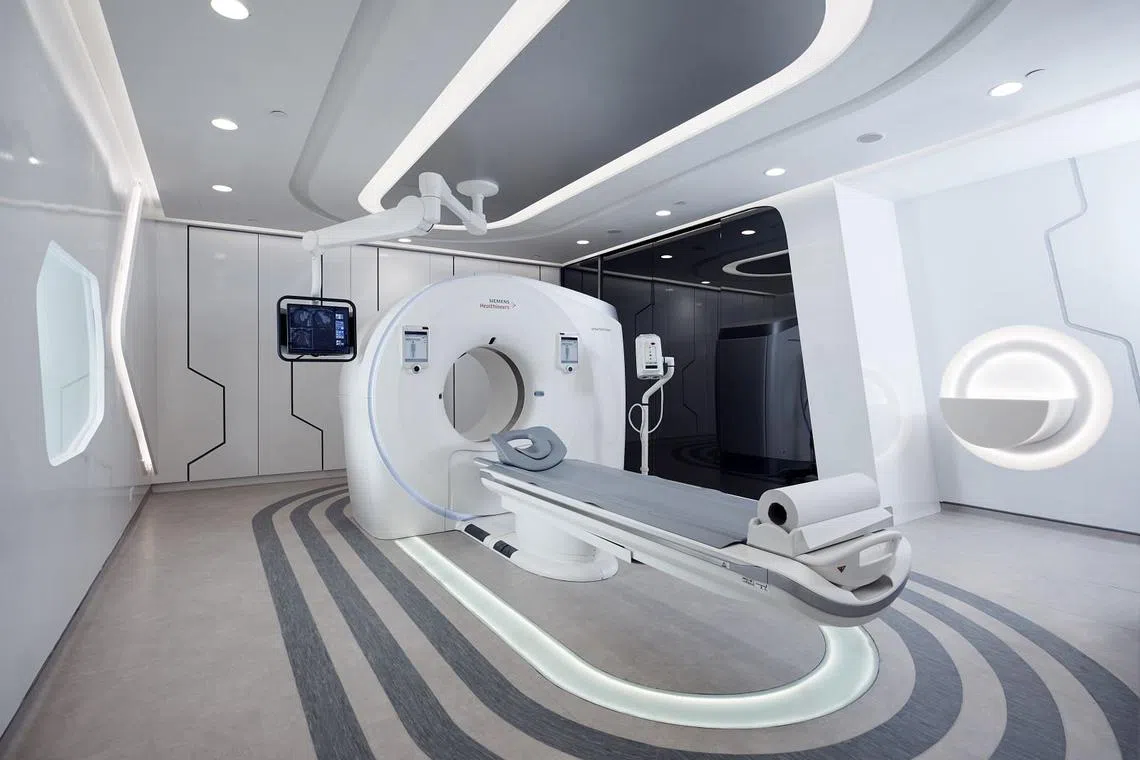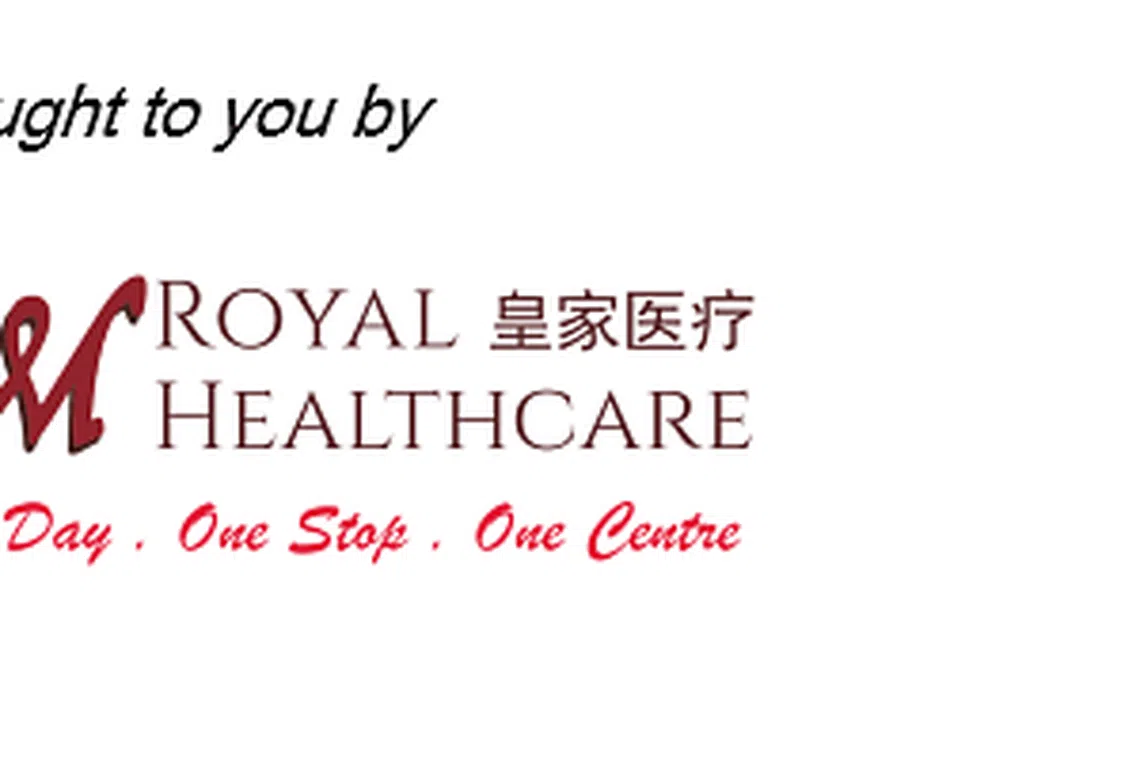From quicker scans to more accurate diagnoses, cutting-edge medical tech are a boon for healthcare
Advancements in medical devices, such as imaging equipment and Lasik tools, help healthcare professionals at Royal Healthcare achieve more precise and safer outcomes for patients
When a patient visited private healthcare group Royal Healthcare in 2020 to seek surgery for a suspected brain aneurysm, both him and the doctors were surprised by the results of his diagnostic tests.
It was the first time the patient had undergone a scan by a new generation computerised tomography (CT) machine, which is able to produce high-quality three-dimensional (3D) colour images. His previous CT scans, the usual black-and-white and lower resolution scan images taken by a different care provider, indicated that there was the possibility of a blood vessel in his brain rupturing in the near future.
Ms Michelle Lim, group chief operating officer of Royal Healthcare, recalls: "The scan done by the advanced CT machine cleared any doubts. The results turned out normal; the only issue was a slightly kinked blood vessel. Depending on which angle you look at it, especially on a lower resolution CT machine, it could possibly be mistaken for an aneurysm."
Royal Healthcare, which was established in 2002, has always been a champion of upgrading its medical technology capabilities to achieve better outcomes for its patients' well-being.
Starting as a family-run heart clinic, it has expanded to provide a comprehensive range of healthcare services. These include specialist healthcare, general medical services, day care surgery, a diagnostic imaging centre and aesthetic medical services.
At Royal Healthcare's diagnostic imaging centre, which has been running for 17 years, state-of-the-art diagnostic machines are used to help patients obtain safer and more accurate diagnoses.
One of its latest centres - the Siemens Healthineers Asia Reference Centre - is run in partnership with German multinational conglomerate Siemens. Opened in October 2018 within Royal Healthcare's 20,000 sq ft facility at Royal Square at Novena in Irrawaddy Road, the centre also functions as a showroom and a training centre.
In addition to the new CT machine, the Siemens Healthineers Asia Reference Centre also utilises an advanced magnetic resonance imaging (MRI) machine that can deliver quicker examinations, better imaging quality and greater patient comfort.
Ms Lim notes: "We were the first in Asia to get this new MRI machine when the centre opened in October 2018. It reduces scan times by up to half, so patients don't need to be in the machine for too long.
"It is also more spacious than a traditional MRI machine, which has a diameter of 60cm compared to this machine's 70cm. So, for patients who have claustrophobia, that additional 10cm can make a world of difference."
The group has been investing heavily in boosting its tech capabilities, from million-dollar machines such as the top-of-the-range CT machine to digital patient-facing systems.
The aim, says Ms Lim, is "to be at the forefront of technology, so that tech and talent can produce very tailored treatment plans with superior outcomes for patients".
She adds: "There are three concepts we try to deliver to our clients: Preventive healthcare, Personalised healthcare, and Precision - the 3 Ps - so that's why our group has been focused on identifying the latest medical technology in the market."
How medtech is reshaping healthcare
In the past, imaging equipment such as CT and MRI machines relied on a standard set of protocols and the skill of the technologist.
Today, artificial intelligence capabilities can help with patient positioning, correctly identifying the various body parts and giving the right radiation dose, as well as producing sharper images by making adjustments for patient movement.
Both the top-notch CT and MRI machines at the Siemens Healthineers Asia Reference Centre are also able to customise scan protocols for individual patients - which means that parameters such as their height, weight and heartbeat can be taken into account, rather than a one-size-fits-all scanning method. This produces more precise imaging for a more accurate diagnosis, akin to having a camera fitted with a smart image stabiliser.
The high-quality 3D colour images of the CT machine also give doctors a much clearer view. "Our doctors are then able to come up with better treatment plans for patients; they can also do the necessary calculations before going to surgery," explains Ms Lim.
Furthermore, the advanced 3T MRI machine is twice the strength as compared to the typical MRI machine. Says Ms Lim: "As a result, we are able to pick up very early-stage cancers for a lot of our patients."
She adds: "We also noticed that when patients are actually able to visualise the 3D colour images themselves, they actually make an effort to change their lifestyle. In the past, when we showed them black-and-white 2D images, they didn't really know what they were seeing. This actually helps a lot in the entire treatment process."
Patient safety is key

Patients who have to undergo diagnostic imaging scans may be concerned about the amount of radiation they will be exposed to, especially those who are young or who need to go for regular scans.
The Radiation Protection (Ionising Radiation) Regulations recommend that the radiation dose be capped at 20 millisieverts (mSv) a year over five years; the effective dose should not exceed 50 mSv in any one year.
Typically, a CT scan of the head (effective dose of 2 mSv) will result in the same radiation exposure as undergoing 100 chest X-rays (each chest X-ray has an effective dose of 0.02 mSv). The CT machine at Royal Healthcare delivers a dose of about 1.5 mSv for a CT brain scan.
At Royal Healthcare, patients benefit from the use of the latest CT machine, which employs a 3D camera to help with body part identification for the right radiation dose and correct positioning. Other advanced components of the machine, such as X-ray tubes and detectors, also enable low-dose scanning while freezing motion artifacts.
Meanwhile, for young patients, the team of doctors and technologists at Royal Healthcare work closely to find ways to minimise their radiation exposure.
The Royal Healthcare team is proud to pioneer the use of Magnetic Resonance Imaging (MRI) for heart scans in South-east Asia since 2012.
Thanks to the team's experience with earlier generations of the MRI machines, this helped them to build their expertise and it enabled them to tweak the machine protocols so that clearer images were obtained. The stringent training of the team have also helped them achieve better diagnostic results for the patients.
With patient welfare at heart, the team uses the MRI machine as it relies on a strong magnetic field to create images of what is inside a patient's body, instead of utilising a CT scan, which emits radiation. MRI scans also generally do not require a contrast injection - which some patients may have an adverse reaction to.
Says Ms Lim: "Since Royal Healthcare was established, it's always been about patient-centric care. So everything we do, from our workflow to the technology we bring in, is all for our patients' good. Just imagine, if your dad or mum walks into a clinic, you'd surely want the best for them."
Royal Healthcare's other tech capabilities
In addition to diagnostic imaging equipment, Royal Healthcare also invests heavily in top-of-the-line surgical equipment as well as other technological capabilities to benefit its patients.
Trailblazer in ophthalmology Royal Healthcare's eye clinic is the first practice in Singapore to pair the FEMTO LDV Z8 with J&J's Star S4 Excimer Laser, one of the most established and trusted excimer lasers. The latter has been the gold standard for LASIK, approved by the United States' FDA even for aviation and aeronautical professionals for decades. This pairing provides a bladeless and truly customised vision correction experience for their patients.
With the FEMTO LDVâ„¢ Z8, it allows the eye clinic to perform Bladeless Z-LASIK (Laser-Assisted In-Situ Keratomileusis) for their patients. A corneal flap is created within 30 seconds by using extremely fast, short bursts of low range pulsed light. This allows access to the underlying cornea tissue. The Excimer laser is then used to treat the eye according to the patient's visual requirements. No stitching is required, visual recovery is quick and there is minimal discomfort.
The newly developed CLEAR (Cornea Lenticule Extraction for Advanced Refractive Correction) is bladeless, flapless, fast and gentle. Performed with the FEMTO LDVâ„¢ Z8, it uses overlapping laser spots with the lowest energy per pulse, thereby allowing smoother incisions with higher precision.
Using this Femtosecond laser alone, a disc of tissue is created underneath the cornea surface. This is known as a "Lenticule" and its thickness is calculated according to the individual's required correction. Subsequently, the lenticule is removed through a small 2mm opening on the cornea surface. The removal of the lenticule changes the shape of the cornea, thus correcting one's vision in a minimally invasive manner. This procedure ensures reduced downtime, quicker recovery with less post-operative dryness and discomfort.
Telemedicine services for patients in regional countries
Royal Healthcare's healthcare professionals see patients from all over the world and, therefore, the group has seen the need to ramp up its telemedicine capabilities. Beyond consultations with doctors, the technology to remotely control machines located abroad is also available at its centres.
Says Ms Lim: "The technology has already been proven between Germany and Singapore. As part of our growth plan, we aim to establish this system with our regional partners in time."
Digitalising the patient journey
For a smooth and holistic patient-centric experience, Royal Healthcare has also digitalised its patient journey. All its systems are interconnected: The moment registration is done via a tablet, the patient journey and visit progress are documented and monitored closely.
"With common electronic records, our multi-specialist doctors can circumvent the duplication of tests or avoid giving medicines that may have contraindications as they work as a team," notes Ms Lim.
"Our patient app also increases the touch points we have with our patients for a more personalised experience. Patients can schedule their appointments with us and view their lab reports, invoices, certificates as well as make payment to our centre, all within the app."

Decoding Asia newsletter: your guide to navigating Asia in a new global order. Sign up here to get Decoding Asia newsletter. Delivered to your inbox. Free.
Copyright SPH Media. All rights reserved.
